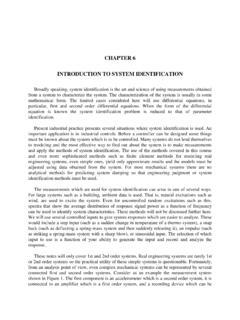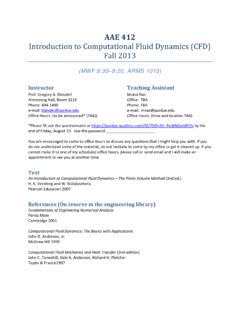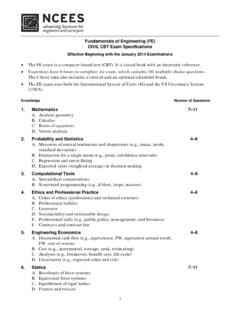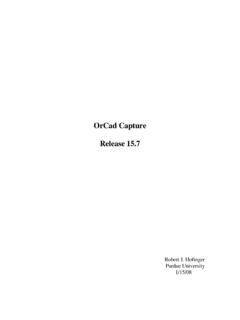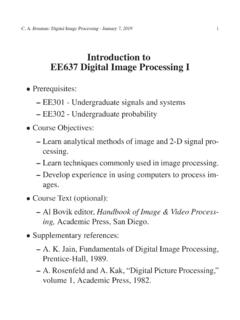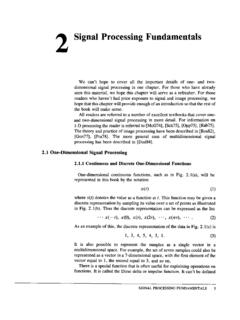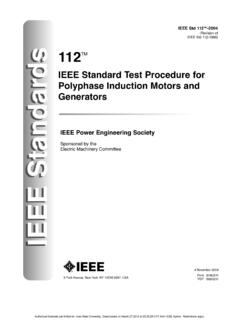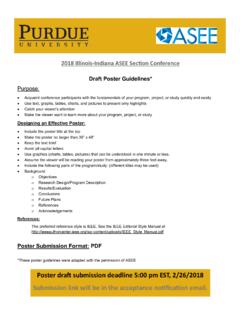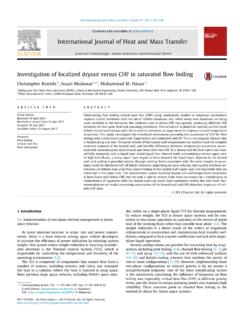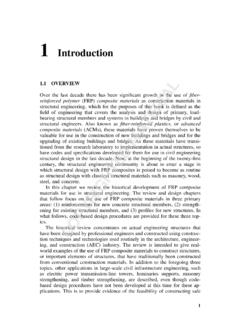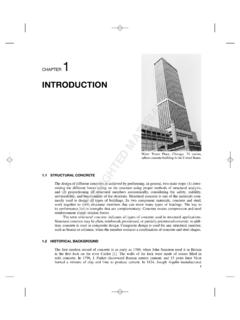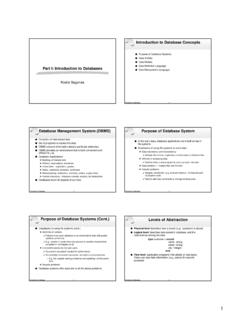Transcription of Introduction to Loudspeakers and ... - Purdue …
1 Introduction to Loudspeakers and EnclosuresD. G. MeyerSchool of Electrical & Computer EngineeringOutline Background How Loudspeakers work Waveforms Wavelengths Speed of sound Speed of sound How sound propagates Sound pressure level (dB) Summation of audio signals Phase wheel Beamwidth 3D directivity balloons How Loudspeakers WorkHow Loudspeakers Are MadeThe WaveformTransmission = C/FC is speed of sound at of sound at ambient conditionsTransmissionHow Sound PropagatesAcoustic Decibel (dB SPL) In acoustics, the ratios most commonly encountered are changes in pressure level, measured in dB-SPL: As distance from a sound source doubles, the dB-SPL decreases 6 dB (this is called dB-SPL = 20 log10(p/po) where po= 20 N/m2the dB-SPL decreases 6 dB (this is called the inverse square law) Adding/subtracting dB levels: Doublingacoustic powercorresponds to a 3 dBincrease in SPL Doubling perceived loudnesscorresponds to a 10 dBincrease in SPLSPLa SPLb = 10 log10[ 10 db-SPLa/10 10db-SPLb/10]TransmissionTransmissionTra nsmissionTransmissionElectrical Power Requirement When SPL goal at a given listening distance known, also need.)
2 Sensitivity rating of loudspeaker (typically spec as 1mon-axis with input of 1 electrical watt) Acoustic level change/attenuation between loudspeaker and farthest listening positionloudspeaker and farthest listening position Example: 90 dBprogram level at listening distance of 32 m outdoors loudspeaker sensitivity measured as 110 dB Acoustic level change = 20 log (32) 30 dB Add 10 dBfor peak (program level) headroom SPL required at source is 90 + 30+ 10= 130 dB Need 20 dBabove 1 watt, or 10 (20/10)= 100 WStable Summation Criteria1. Must have matched origin2. May contain unlimited multiple inputs3. May arrive from different directions4. Must have significant overlap durationSummation Criteria: Matched Origin SummationSignal 1 Signal 2 Summed Signal SummationSignal 1 Signal 2 Summed SignalSummation Criteria: Matched Origin SummationSignal 1 Signal 2 Summed Signal SummationSignal 1 Signal 2 Summed Signal?
3 Summation Criteria: Multiple Input SignalsSummed Signal SummationSignal 1 Signal 2 Signal 3 SummationSignal nSignal 3 Signal 4 Summation Criteria: Input Signal DirectionSummation Criteria: Overlap DurationSummed Signal SummationS 2S 1 Addition/subtraction during overlap duration SummationS 2S 1 Summed SignalNo addition/subtractiondurationAdding dB-SPL dB-SPLa+b= Two acoustic sources a and b of relative phase angles aand bdB-SPLa+b20 log10[sqrt { (10dB-SPLa/20)2+ (10dB-SPLb/20)2+ 2(10dB-SPLa/20) (10dB-SPLb/20)(cos( a- b))} ]Adding dB-SPL Simplifications If both sources are in phase and only the relative levelvaries (where source a is 0 dB, simplifies to: dB-SPLa+b= 20 log10[1 + 10dB-SPLb/20 ]If both sources are at 0 dB and phase angle a= 0 ( , same level, only relative phase angle varies), simplifies to : dB-SPLa+b= 20 log10[ sqrt { 2 + 2cos(- b) } ]Acoustic Addition & Subtraction: The Phase Wheeltwo identical signals summed at same levelAcoustic Addition & Subtraction: Level vs.)
4 Phasetwo identical signals summed at same levelFactors Affecting Response at Summation offset due to distance offset (inverse square law) offset due to polar response (frequency dependent)(frequency dependent) offset due to path length differenceSummation: Response offsets shift all frequencies by the same amount of offsets shift all frequencies by a different amount of phasedifferent amount of of summation with time offset (of signals at same frequency) is response ripple Summation Zones Defined Coupling zone Sources within 1/3 wavelength ( 120 ) Amount of addition ranges for 0 to 6 dB depending on phase/level offsetdepending on phase/level offset Ripple is 3 dB Most easily achieved at low frequencies due to large wavelengthsSummation Zones Defined Cancellation zone Effects only subtractive Phase offset 150 to 180 Ripple 50 dB Ripple 50 dBSummation Zones Defined Combing Zone Phase offset reaches point where subtraction begins (> 120 )
5 Less than 4 dB level difference Less than 4 dB level difference Characterized by addition at some frequencies and dips at others Ripple ranges from 6 dB to 50 dB To be avoided highest form of variance over frequencySummation Zones Defined Combining Zone Level offset ranges from 4 dB to 10 dB Semi-isolated state relative to sources, which limits the magnitude of addition/cancellationlimits the magnitude of addition/cancellation Ripple no more than 6 dBSummation Zones Defined Isolation Zone 10 dB or more of level offset Relative interactions steadily reduced and eventually become negligibleeventually become negligible At large level offset, relative phase has nominal effect Ripple does not exceed 6 dBSummationAcoustic Addition and Subtraction: Level Offset EffectsLevel Offset e v e l C h a n g e ( d B )Relative Phase=0 degRelative Phase=180 degMax OffsetL e v e l C h a n g e ( d B )Max Peak HeightMax Null DepthMax RippleSummationApplication loudspeaker mounted in a rigid (undamped) pipe 3 feet in length, open at one end, observed on-axis from speaker end 3 feetApplication how does sound propagate at low frequencies?
6 3 feetApplication how does sound propagate at low frequencies?3 feetApplication if operated at 150 Hz, how much phase shift occurs as the wave traverses the pipe?3 feetApplication if operated at 150 Hz, how much phase shift occurs as the wave traverses the pipe? wavelength = feet; phase shift = (360x3) = 143 degrees3 feetApplication what will be level of combined signal at observation point?3 feetApplication what will be level of combined signal at observation point? total round trip phase shift = 180+143+143=466 degrees (106 degrees net); combined level will be dB3 feetApplication if frequency changed to 100 Hz, what will be combined level? wavelength is feet; phase shift traversing pipe 96 degrees; round trip phase shift is 371 degrees (nearly in phase ); combined level is + dB3 feetCoverage / BeamwidthCommon Representations of loudspeaker Coverage Coverage angle C<(H / V) = 6 dB Beamwidth Polar pattern Equal level (isobaric) contours ( isobars ) Directivity factor (Q) Directivity factor (Q) Directivity index (DI) = 10 log Q (also known as front to back ratio ) Beamwidth vs.
7 Frequency 3D balloons TransmissionExample: Piston radiation into half-space ( , a cone-type loudspeaker mounted in an infinite bafflethink of piston as consisting of a large number of very small elements of size general, want ka for a cone radiator, where k = 2 f/c Examples: For 12 woofer, want f 1378 Hz For 4 midrange, want f 4134 Hzcentral lobe onlypair of out-of-phase side lobesadditional pair of in-phase side lobesSingle 4-inch LoudspeakerSingle 4-inch loudspeaker @ 500 HzSingle 4-inch loudspeaker @ 1000 HzSingle 4-inch loudspeaker @ 2000 HzSingle 4-inch loudspeaker @ 4000 Hz32-Element Array of 4-inch Drivers32-Element Array @ 500 Hz32-Element Array @ 1000 Hz32-Element Array @ 2000 Hz32-Element Array @ 4000 Hz Home Stereo Multi-way System Home Stereo Multi-way System Home Stereo Multi-way System Home Stereo Multi-way System Home Stereo Multi-way System Home Stereo Multi-way System Home Stereo Multi-way SystemOutline Overview of enclosure types Infinite baffle Sealed box Bass reflex (vented/ported))
8 Passive radiator Passive radiator Horn (front and rear loaded) Transmission line (labyrinth) Tapered tube (damped pipe/ waveguide )Infinite BaffleSealed BoxBass ReflexMeasurement of loudspeaker Free-Air Resonance Passive RadiatorComment: primarily applicable to subwoofer designCompound / Band-passComment: primarily applicable to subwoofer designFront-loaded HornComment: primarily applicable to mid/high frequenciesRear-loaded HornComment: physically large!Transmission Line / LabyrinthLength of transmission line has to be long enough to provide at least 90 of phase shift (1/4 of longest wavelength of interest)Phase shift (degrees) = 360 x L / (C/F)where L is effective length of labyrinth, C is speed of sound, and F is frequency of operation (note add 180 due to rear radiation)Transmission Line / Labyrinth Transmission line typically heavily damped (stuffed with acoustic material) to absorb energy from rear vibrating surface (or limit radiation from vent to low (or limit radiation from vent to low frequencies) Labyrinth typically lined (with acoustic absorption material))
9 But otherwise substantially open (radiation from vent limited to low frequencies)Damped Pipe Pipe driven at one end and open at the other will resonate at a frequency of Fres= C/ 4L, where Cis the speed of sound (1130ft/sec at 72 F) and Lis the effective length of the pipe (Fis called its effective length of the pipe (Fres is called its quarter-wavelength tuning frequency) The effective (or acoustic ) length of the pipe may be longer than its physical length Use of tapering and/or acoustic absorption material can increase the effective lengthDamped Pipe / Tapered TubeIllustration from: G. L. Augspurger, Loudspeakers on Damped Pipes, J. Audio Eng. Soc.,vol. 48, pp. 424-436 (2000 May).Bose AWR1 Waveguide Illustration from: Fig.)
10 4 of Patent 6,278,789 Bose WRII Waveguide Illustration from: Fig. 6B of Patent 7,565,948 Bose WRII Waveguide Illustration from: Fig. 9 of Patent 7,584,820 Summary Viable enclosure types for project sealed box bass reflex / tuned port transmission line / labyrinth transmission line / labyrinth coupling chamber + (tapered) damped pipe Materials supplied half sheet (4 x4 ) of 3/4 MDF (cut per your specs) acoustic lining/stuffing material PVC pipe and couplers (per your specs) glue (carpenter s yellow, PVC cleaner/cement)References loudspeaker Design Cookbook, Vance Dickason (any edition) Patent 3,523,589 High Compliance Speaker and Enclosure Combination Patent 4,655,315 Speaker System Patent 5,821,471 Acoustic System Patent 6,278,789 Frequency Selective Acoustic Waveguide Patent 6,278,789 Frequency Selective Acoustic Waveguide Damping Patent 7,426,280 Electroacoustic Waveguide Transducing Patent 7,565,948 Acoustic Waveguiding M.
